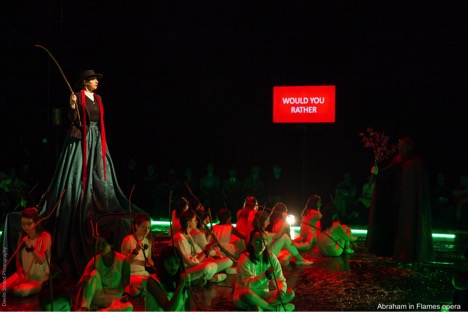Abraham in Flames
Songs of Resolve and Resilience

Sassan Tabatabai
The scene opens to a group of teenage girls on a dark stage. They are all dressed in white and huddle together on the black stage like snowflakes on volcanic rock. A haunting voice can be heard in the background: “Everything starts with a question,” sings the voice. “Would you rather be happy? Would you rather be dim and happy or knowing and suffer?”
This is the opening scene of Abraham in Flames, an opera by Niloufar Talebi. Talebi’s libretto, set to the musical score by composer Aleksandra Vrebalov, and directed by Roy Rallo, tells the story of Girl (sung collectively by The Young Women’s Chorus of San Francisco), a teenager grappling with the creative sensibilities of a budding artist on the verge of entering adult life and trying to come to terms with her own artistic vision. The opera is inspired by Talebi’s own coming of age story in Tehran following the Islamic Revolution of 1979, and her association with the Iranian poet, Ahmad Shamlou (1925-2000), who frequented her parents’ literary salons. The title of the opera is taken from the title of Shamlou’s 1973 book of poems, Abraham in Flames (also translated as Abraham in the Fire).
Niloufar Talebi was born in London and lived in Tehran from 1980 to 1984, during the tumultuous early years following the 1979 Islamic revolutionary period in Iran, before moving with her family to the United States. As so many others of her generation who migrated from Iran at an early age, she grew up on the cusp of two cultures. The cultural marchlands, which mark her identity are also an emblem of her creative work that often blurs the line between genres.
The expanded story of Abraham in Flames is told in Talebi’s memoir, Self-Portrait in Bloom (l’Aleph, 2019). It is a work that straddles biography and autobiography and paints parallel portraits of both Talebi and Shamlou that link the artistic life of the writer to the poet who is more than four decades her senior. There is a cinematic quality to the narrative where the author’s reflections oscillate between the universal that strikes at the human condition, and the personal, which is recorded in minute detail. The constant broadening and narrowing of the lens through which Talebi presents her reflections go hand in hand to shape her personality. The result is a self-portrait in which the image of the older poet hangs in the background. The memoir also includes a selection of Shamlou’s poetry translated into English by Talebi.
Ahmad Shamlou, who also wrote under the pen name “Alef Bamdad,” is considered one of the most significant Iranian poets of the twentieth century. A socially conscious poet and an outspoken critic of autocracy, his work was subjected to censorship and he was imprisoned twice during the reign of Mohammad Reza Shah Pahlavi. A prolific writer who published nineteen books over the course of his literary career, Shamlou was nominated for the Nobel Prize in Literature in 1984.
For Shamlou, the artist has a responsibility to tell the truth as he or she sees it, even if it comes at a great price. Abraham in Flames is inspired by the story of the Old Testament patriarch, Abraham. Although Genesis bypasses Abraham’s childhood, there is a 2nd century CE Midrashic account that elaborates on his early years. This is a story that echoes in the Koran, where the young Abraham is cast as a breaker of idols. According to the story, Abraham is forced to undergo a trial by fire for his transgression against the idols. Ultimately, he is not harmed by the fire. Abraham emerging from the trial unscathed was seen by Shamlou as an expression of freedom and an allegory for the artistic soul that refuses to succumb to tyranny and the might of the stronger. In Self-Portrait in Bloom, Talebi describes Shamlou’s Abraham in Flames as “a dark book about standing up to oppressors, evoking images of falling to bloody deaths in public squares, braving trials by fire, the intermingling of earth and blood, and fields of flowers blooming from bloodshed.” The cover image of Talebi’s memoir also evokes flowers blossoming from a blood-soaked earth, a mirror of her own story of reinvention in the aftermath of an attempted silencing.
In Talebi’s translation of “Nocturne,” one of the poems from Abraham in Flames, Shamlou writes:
If it is beautiful in vain, night,
then why is it beautiful,
night
for whom it is beautiful?—
Night
and its unelliptical river of stars
that run a cold path.
And reliving which memory
with the breathtaking ode of toads
do long-haired mourners
on both banks of the river
lament
when each dawn
is pierced
with a chorus
of twelve shots?
If it is beautiful in vain, night,
then why is it beautiful, night
for whom is it beautiful?
Where Shamlou and Talebi overlap is not just the personal, artistic drive for self-expression, but the unshakeable resolve of standing by one’s convictions regardless of the risk and repercussions. This is the overriding sentiment expressed in the opera.
As Talebi’s opera and memoire build to a crescendo, the finale of Abraham in Flames is echoed in the coda of Self-Portrait in Bloom, and the opening question, which acts as a framework for the opera—“Is it better to be dim and happy or knowing and suffer?”—is answered with an emphatic, “To be dim and happy and to know and suffer is the incessant rise and fall and rise again.”
SASSAN TABATABAI is Guest Editor of Mizan Pop.


